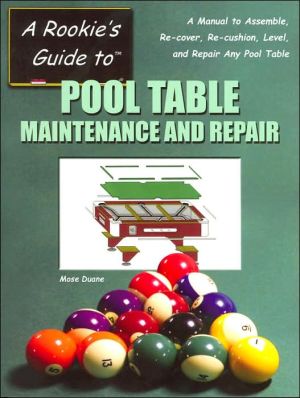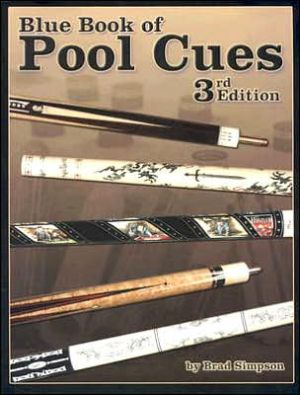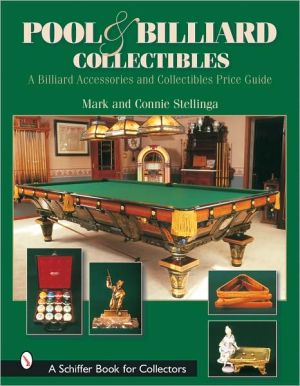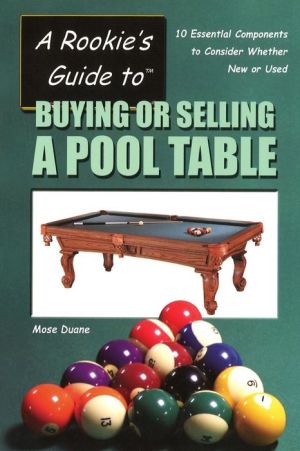Rookie's Guide to Pool Table Maintenance and Repair: A Manual to Assemble, Re-Cover, Re-Cushion, Level, and Repair Any Pool Table
Search in google:
A Rookie's Guide To POOL TABLE MAINTENANCE & REPAIR\ A MANUAL TO ASSEMBLE, RE-COVER, RE-CUSHION, LEVEL, AND REPAIR ANY POOL TABLE \ \ By Mose Duane \ Phoenix Billiards\ Copyright © 2000 Mose Duane\ All right reserved. \ ISBN: 0-9678089-8-7 \ \ \ Chapter One\ RAILS \ There are three kinds of pool table rails commonly used today-T-rails, flat rails, and detachable (coin-operated table) rails (Figure 1-1). One kind is not necessarily better than the others, although detachable rails are generally found on tables in which the rails are not connected to the slate, making them inferior from a playability standpoint, and I like the solid rebound of a good flat rail.\ Top quality rails are made from select hardwoods that give the table a lively and solid playing characteristic. Some are finished woods, while others are laminated with plastic.\ Although some quality rails have durable laminates over hardwoods, which makes a good-looking, functional rail, other lower quality rails are constructed from softwoods and particle boards, and use inexpensive, paper-thin plastics that look good for a while, but are subject to peeling and skinning.\ Three problems develop with the use of softwood and particle board rails. First and foremost is the apparent inability of these materials to hold glue. Laminates and cushions may peel or sag leaving either ugly rails with blisters and bubbles, or cushions that will not rebound properly. Second, these materials are not capable of holding screws or nails over time. Rails become loose, aprons fall off, pockets become detached, and so on. Third, instead of the feather strip (discussed later in this chapter) compressing to hold the cloth the grove opens, allowing the cloth to pull away, often permanently damaging the rail.\ On The Level\ A while back, I gave my bill to a doctor, for moving and recovering his table.\ "Jesus," he said, and clearly looked annoyed. "You make more money than I do."\ I looked at him and smiled. "What's your point, Doc? I would imagine lots of people make more money than you."\ "Yes, but I'm a ... I mean you're just a ..." Stumbling for words, he tramped off to get his check book.\ You gotta love it!\ T-RAILS\ T-rails are most often found on older tables. They are usually constructed by bonding three pieces of hardwood-the top rail, the tacking strip, and the base-together in, more or less, a T shape (Figure 1-2).\ The top rail is made from a decorative wood, such as rosewood, ash, oak, mahogany, and so forth. Occasionally the top rail is made of a low-grade softwood or particle board and laminated with a high quality (usually wood grain) plastic, like Formica.\ The tacking strip and base are most likely made of poplar. Trails are attached with bolts from the side, screwing into lugs that have been leaded into the slate. This system of attachment is one of the oldest, but certainly not the easiest, cheapest, or best.\ T-rail bolts can be hex-head with standard threads, but most antique tables have a nonstandard, thrust-head bolt with two holes that accepts a fork type tool instead of a standard wrench or socket (Figure 1-3). This tool can be ordered from most pool table supplies stores.\ After installation, the bolt heads are hidden with either individual ornamental rosettes or a decorative apron that covers the entire rail base, including the bolts (Figure 1-4).\ FLAT RAILS\ Flat rails are usually constructed by bonding two pieces of wood together-top rail and base-but can be cut from one block of wood. The top rails of high quality tables are made from an appealing hardwood like rosewood, ash, oak, maple, etc., and the base from an unappealing hardwood such as poplar. Less quality rails could have a top rail laminated with a good quality plastic, but underneath it can be made from almost anything: softwoods, particle board, pressed fiberboard, or some combination, with the base also made from a similar inferior material.\ Quality flat rails are attached to the table with rail bolts that penetrate up through the slate and into the rail, which has been equipped with lugs (Figure 1-5), which are imbedded in the rails between the top rail and the base to create a solid attachment.\ Generally, flat rails are the better of the three kinds-flat, T, and detachable-because of the positive bottom attachment to the slate. However, some manufacturers bypass the use of lugs altogether by using large wood screws or lag screws. In time, these can become loose, causing a weak connection. Other manufacturers use a flat lug that is screwed to the bottom of the rail with small wood screws. The lugs are only as solid as the wood and screws that hold them (Figure 1-6).\ The ends of some flat rails are cut square to accept leather pockets or rail castings (rail 1 in Figure 1-7), while others are mitered to fit together much like a picture frame (rail 2 in Figure 1-7). Squared rail ends allow exposed leather pockets and mitered ends (and rail castings) allow pockets or pocket liners to be attached inside the rail assembly. The converging joints of mitered rails are often covered with a plastic or metal trim.\ Aprons\ Some T-rails and all flat rails have an apron to hide the edge of the flame and slate (Figure 1-8). Aprons are either glued permanently to the base, are screwed onto the base or frame, or are attached with metal brackets or wood blocks (see Chapter 8). Except for rails with leather pockets, aprons are joined at the corner with plastic or metal apron corners, and rails are joined with rail caps or castings.\ The length of an apron should be the same as the rail that it is attached to. The apron's width can be anything that adds to the appearance of the pool table but should hide the edge of the slate and frame. Usually, though, narrow aprons are 3 to 4 inches wide, while wide aprons are 6 to 8 inches wide.\ The apron's thickness varies from 1/4 to 3/4 inch, and is of no structural significance.\ DETACHABLE RAILS\ Detachable rails are generally found on coin-operated tables (Figure 1-9), although a few "home-style" tables also have them. A detachable rail is simply a wooden (tacking) strip with cushion rubber and facings glued to it; it is that portion of the assembly covered with billiard cloth. The top rail is permanently (more or less) attached to the frame, thereby becoming part of the cabinet.\ Generally, the detachable part of the rail is attached to the top rail in one of three ways: side mount, bottom mount, or metal clip (Figure 1-10).\ The most common is the side mount rail that has three or four long bolts (or screws, which are ineffective) that penetrate the width of the top rail and screw into the detachable portion of the rail. The bottom mount rail has an L shaped tacking strip that slides beneath the top rail and is secured from the bottom. The metal clip mount rail has an unusual metal fastener that slides into the middle of the top rail allowing the bottom to hinge beneath the base where it is fastened. The bottom and metal clip mounts are becoming rare but some still exist. They are usually found on home-style tables.\ The advantage of the detachable rail method over the T-rail or flat rail is the ease in which an owner can disassemble the table to move or re-cover it. The disadvantage is that detachable rail tables are built with undersize slate that extends only to the edge of the rail; the rail is attached to the frame instead of the slate. The problem with this system is a rail assembly that allows poor ball action.\ RAIL DIMENSIONS\ Some rail widths are as narrow as 2 inches while others are as wide as 8, depending on manufacturer and style of the table (Figure 1-11).\ Rail lengths (Figure 1-12) vary somewhat from manufacturer to manufacturer, but not by much.\ Rails must fit within the constraints of the playing field size, so they must be consistent in their length. However, inconsistencies do occur between tables because no set dimensions for leather pocket setbacks, length of drop pocket castings, or length of miters exist. The further the corner pockets are set away from the table the longer the rails must be-if the setback changes, the rail length must also change, and vice versa (see Chapter 2).\ Rail lengths are figured by measuring that part of the rail covered with cloth; that is the measurement that ultimately determines the size of the playing field of the table.\ RAIL BOLTS\ The hardware that holds the rail assembly to the table is the rail bolts or screws (often called hanger bolts). There are three types of rail bolts.\ 1. T-rail bolts pass through the side of the rail's base and fasten into lugs implanted in the slate (see Figure 1-2).\ 2. Flat rail bolts go up through the bottom of the table bed (usually penetrating the slate) to fasten into lugs in the rails (see Figure 1-5).\ 3. Detachable rail bolts pass through the side of the top rail into lugs affixed in the detachable rail (see Figure 1-9).\ Lag bolts or wood screws used for rails bolts or lugs simply screw into the bottom of the rail, and most are ineffective.\ All rail bolts or screws should be locked with lock washers.\ The length of the rail and the number of rail bolts used determines spacing or distance between rail bolts. Typically a three-bolt, 4 x 8 table rail will have rail bolts that are approximately 16 inches on center, with the middle bolt placed in the middle of the rail (Figure 1-12). The pattern for a four-bolt, 4 x 8 table rail will be approximately 12 inches on center, starting 6 inches on both sides of the center of the rail.\ CUSHION RUBBER\ Quality cushion rubber is molded from 100 percent pure gum rubber. Some cheaper cushions are extruded rubber or synthetics, or molded rubber diluted with fillers.\ The two most common cushions are the triangular shaped K-66 and U-23 (Figure 1-13).\ K-66 profile is a high-speed cushion used on most commercial and home-style tables. U-23 profile is a medium speed rubber and is used on most coin-operated, and some home-style tables. Although the two cushion types may look the same, they can be distinguished by their size.\ K-66 is usually 1 3/16 inches high by 1 1/8 inches wide (back to nose), and U-23 is usually 1 inch high by 14/16 inches wide. Canvas is molded to the back of most cushion rubber to give it a bonding surface, and to the top to control speed, accuracy, and consistency of ball rebound.\ Tables equipped with a non-gum and non-conforming profile rubber should be re-cushioned with their specific rubber. The availability of such rubber depends on the age of the table and the manufacturer. However, it is often possible to re-cut the angle of the rail to accept either U-23 or K-66 profiles (see Chapter 22).\ Cushion Height\ The critical dimension of a rail is the height of the cushion nose above the playing surface. The cushion nose is that part of the cushion that makes contact with the ball.\ When the cushion is at the correct height (rail 1 in Figure 114), the nose should be between 61 and 64 percent of the ball height (BCA says 621/2 percent plus or minus 1 percent).\ If the cushion nose is too high, the ball will be forced down onto the slate making the rebound dull and slow (rail 2 in Figure 1-14). If the cushion nose is too low, the ball will be propelled up causing it to hop as it rebounds (rail 3 in Figure 1-14).\ Cushion nose height is determined according to the game ball size. The actual rail thickness and cushion attachment angle do not have to be any set dimensions as long as the cushion nose height remains constant. That is, if the thickness of a rail varies then the angle at which the cushion is attached must also vary, and of course, vice versa. However, most rails using full profile (K-66) cushions have dimensions similar to those in Figure 1-15.\ CUSHION FACINGS\ Facings are attached to the ends of the cushion and rail to protect them and the rail cloth from excessive wear (Figure 1-16). Facings also deaden the ball's rebound when it is struck, which forces the ball into the pocket. Most facings are laminated rubber and canvas, or cork.\ FEATHER STRIPS\ Feather strips are long thin pieces of wood or plastic used to securely wedge the rail cloth into the top of the rail (Figure 1-17). Feather strips are as long as the rail and fit, along with the rail cloth, into a grove in the top rail.\ SIGHTS\ Sights (Figure 1-18) can be inlaid into the top rail with a variety of materials. Some older tables have ivory sights, but the most common material is abalone mother-of-pearl, or plastic that resembles mother-of-pearl. Inexpensive tables may have ink-screened sights, or upholsterers' tacks, or cover plates that hide the rail bolts that penetrate the top rail in roughly the sight area. (See Chapter 3, Figure 3-6 for sight spacing.)\ Whatever the material, sights were originally strategically located on the rails for aiming purposes. There is a mathematical scheme called The Diamond System that can be used to figure angles for bank shots using the sights. The process was originally intended for carom play but works well for any kind of pool table or game. The system employs the application of english and immediate mental calculations during a shot (which is extreme exertion for most of us) and is, therefore, generally ignored. For more information, The Diamond System is explained in several "how to make shots" books and the Billiard Congress of America's (BCA) official rules book. BCA's booklet can be purchased from most pool table supply stores, phoenixbilliards.com, or directly from: Billiard Congress of America, 4345 Beverly Street, Colorado Springs, CO 80918\ (Continues...)\ \ \ \ \ Excerpted from A Rookie's Guide To POOL TABLE MAINTENANCE & REPAIR by Mose Duane Copyright © 2000 by Mose Duane. Excerpted by permission.\ All rights reserved. No part of this excerpt may be reproduced or reprinted without permission in writing from the publisher.\ Excerpts are provided by Dial-A-Book Inc. solely for the personal use of visitors to this web site. \ \



